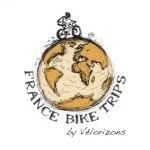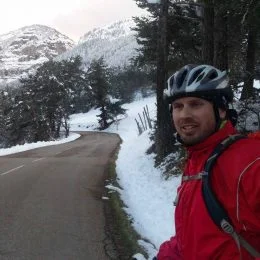The Route des Grandes Alpes is one of Europe’s iconic cycling routes, taking you through the French Alps, from Geneva to Nice.
This 720 kilometre traverse of the Alps winds along mountain sides, glaciers, mountain pastures and forests, taking in around 17,100m of climbing and 18 major cols; mythical beasts such as the Col de l’Iseran, Col du Galibier, Col du Lautaret, Col d’Izoard.
It’s one of the must-do cycling tours in France (and Europe) but it’s not for beginners!
Insider guide: Route des Grandes Alpes
It’s a journey that’s been on our bucket list for many years now, so when Vélorizons offered to share the inside story on the Route des Grandes Alpes cycle tour, we jumped at the chance.
Vélorizons is a well-established cycling tour operator in France; France Bike Trips is their English-language branch.
Vincent is Vélorizons’ road cycling product manager; he’s been planning cycling holidays in the Alps for fifteen years.
Of all the routes he’s planned and led trips on, Vincent tells us that this is one of his personal favourites.
Here he shares his tips.
Vélorizons’ UK language brand is called France Bike Trips (www.france-bike-trips). Throughout this article we will refer to Vélorizons (as it’s shorter!). Details of their Route des Grandes Alpes trip are here. Note all distances and gradients etc in this article are approximate.
Part 1: Route des Grandes Alpes cycle route
1. Tell us about the Route des Grandes Alpes cycle tour
How did it start?
The Route des Grandes Alpes dates all the way back to 1860, when Napoleon III annexed Savoie and Nice to France. The army was told to build roads to open routes between the valleys of France and into the newly annexed Savoie and Nice.
A few years later, the Touring Club de France got interested and in 1909, the vice-president of the Club, Leon Auscher, said “It will be a unique route in Europe… and the finest mountain road in the world.”
The Route des Grandes Alpes’ original itinerary was inaugurated in 1937. Today the Route des Grandes Alpes remains one of the most famous and beautiful European cycle routes.
Some statistics…
The route crosses the entire French Alps from north to south, taking in 18 high mountain passes (cols).
Six of the cols are over 2,000 metres high: Col de l’Iseran, Col du Galibier, Col du Lautaret, Col d’Izoard, Col de Vars and Col de la Cayolle. Other famous Tour de France climbs include the Col de la Colombière, Col des Aravis, Col des Saisies, Cormet de Roselend, Col du Télégraphe and Col du Turini.
This legendary Geneva to Nice cycling tour starts in the lovely town of Thonon-les-Bains on the shore of Lake Geneva and ends in Nice on the Côte d’Azur (not far from Nice).
In total, cyclists have to cover 710 km in distance and a total of 17,100 metres of climbing.
 Cycling up Col de l’Iseran
Cycling up Col de l’Iseran Reaching mineral environment in the second last hairpin of the Col du Galibier
Reaching mineral environment in the second last hairpin of the Col du Galibier2. What makes cycling Geneva to Nice on the Route des Grandes Alpes one of the best cycle routes in Europe?
The Route des Grandes Alpes sits up there alongside Route 66 or the Silk Road as one of the most beautiful roads in the world. It’s also one of the toughest and longest classic road cycling itineraries there is.
Crossing the French Alps, from North to South, from lake shore to Mediterranean coast, by bike is really something special.
The scenery is incredible; panoramic view follows panoramic view.
You also get the chance to appreciate the variety of Alpine landscapes along the way, from Mont Blanc to the Southern Alps and finally to the hinterland of Nice; it’s amazing how different the landscapes look when you’re cycling through the Alps day after day, one mountain range after another.
For those that like to tick off the famous cols, the route gives you the chance to conquer some of the most iconic climbs of the Tour de France and some of the highest paved roads in Europe. Staying in the Alpine villages also really gives you a feel for the local culture and local passion for the Tour de France.
The authentic produce is fantastic too – for example Alpine cheese specialities such as Beaufort, Abondance and Tomme de Savoie. You definitely have to taste them as you pass through the regions!
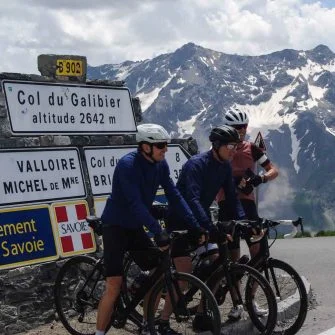 Galibier summit with the Ecrins mountains in the background
Galibier summit with the Ecrins mountains in the background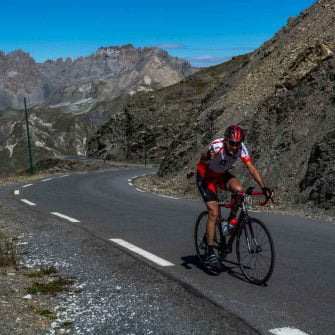 Cycling up Col du Galibier, Rochers de la Pare in the background
Cycling up Col du Galibier, Rochers de la Pare in the background3. Give us a feel for what each day is like
Our Route des Grandes Alpes cycle tour takes eight full days of cycling. It takes in all the major sections of the Route des Grandes Alpes, but improves on it to avoid main road sections with higher traffic volume, notably in the valleys.
We offer two different levels of route, level 2 and level 3. Level 2 is slightly easier than level 3 and most closely follows the classic Route des Grand Alpes itinerary.
There’s no such things as an easy day on this trip – but relatively speaking, if you choose level 2, days 1, 5, 6, and 7 are slightly easier. The hardest days are between days 2 and 5.
We always recommend our guests take it easy on the first days, based on your experience, and listen to their body throughout the trip in order to adapt their effort. If you’re on one of our trips, you can choose the level each day, depending on how you’re feeling and whether you prefer the look of the level 2 or 3 route that day.
Day 1 Thonon-les-Bains – La Clusaz: Crossing the Chablais mountains
Day 1 of your Geneva to Nice cycle challenge takes you into the idyllic Chablais mountains.
The beautiful valleys of Abondance and Giffre and the Portes du Soleil resort area offer us the perfect conditions to get our legs turning. Things get serious when attacking the Aravis mountain range with their sharp-edged peaks and impressive rocky crags.
The first real challenge is the Col de la Colombière: from the start in Marnaz, a ramp with 11% awaits. When the gradient calms down around Le Reposoir, spare some energy for the upcoming finish of La Colombière, roughly 3 km with 10% in average (especially challenging on hot days).
On top of the Colombière, the pine forests give way for the first time to the picture-book Savoy Alpine pastures.
In the descent we reach Le Grand-Bornand and La Clusaz, both well-known ski resorts known for the beauty and authenticity of their chalets. Cowbells dominate the soundscape for the evening of our first stopover.
Route variant
On our level 3 trip, we also take in the difficult Col du Joux Plane from Morzine with 7 km above 9 % (1 km at 11 %). You’ll recognise it from the Tour de France stages!
Cols of the day
Col de Jambaz (1,027 m) (level 2 only)
Col de Joux Plane (1,712 m) (level 3 only)
Col de la Colombière (1,613 m)
Distance and climbing
Level 2: 90 km and 2,200 m
Level 3: 120 km and 3,300 m
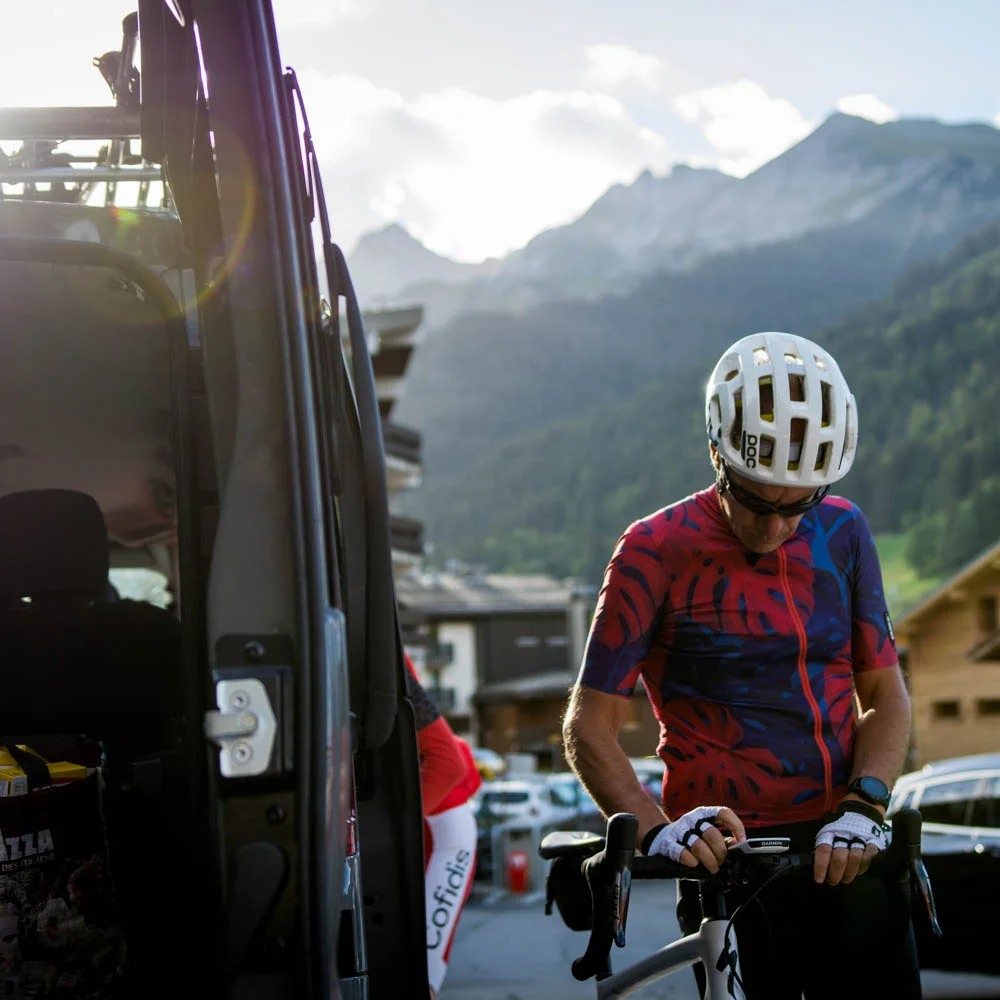 Early morning routine: Getting started in the Chablais
Early morning routine: Getting started in the Chablais Full cycling freedom in the long and spectacular Alpine descents
Full cycling freedom in the long and spectacular Alpine descentsDay 2 La Clusaz – Bourg Saint Maurice: Into the heart of the French Alps
On the second day, you leave the Pre-Alps and enter more serious terrain.
First things first: you start with the climb up the Col des Aravis (1,486 m) with its perfectly laid-out hairpin bends amidst the Alpine meadows.
From the pass you have a breath-taking view of Mont Blanc and its glaciated neighbouring peaks.
You then enter the narrow gorge valley of the Val d’Arly, which you leave shortly afterwards towards the cross-country skiing resort of Les Saisies, seated at 1,650 m.
You now descend into the Beaufortain, a picture-book landscape of chalets, alpine meadows, mountain forests and mountain peaks. Beaufortain is also famous for its firm, raw cow’s milk cheese of the Gruyère family.
From here you can also spot the rocky spur of the Pierra Menta in the distance, landmark of the well-known ski mountaineering event.
A little further on and you are already climbing the Cormet de Roselend (1,967 m), whose picturesque reservoir awaits with its turquoise waters.
The last descent is into the Tarentaise valley, one of the two main valleys of Savoie, under the gaze of the Aiguille des Glaciers.
Today’s overnight stay is in Séez above the town.
Gradients remain moderate between 6-8 % on today’s cols.
Route variant
On our level 3 trip, you can take in a return journey to Col du Joly and a more difficult ascent of the Cormet de Roselend via the Col du Pré (average of 8% with some ramps reaching 11%). The Col du Joly is a natural balcony of the Mont Blanc, offering an exceptional panoramic view of the Mont Blanc range, the Contamines valley and the Aravis mountain range.
Cols of the day
Col des Aravis, 1,486 m
Col des Saisies, 1,650 m
Col du Joly, 1,989 m (level 3, optional return ride)
Col du Pré, 1,703 m (level 3)
Cormet de Roselend, 1,967 m
Distance and climbing
Level 2: 90 km and 2,600 m
Level 3: 100 km and 2,800 m (Col du Joly option: + 28 km and 900 m)
 Savoy cowbells: you will hear them ring especially on the first 3 days of the trip
Savoy cowbells: you will hear them ring especially on the first 3 days of the trip Route des Grandes Alpes: Steady gradients with magnificent views
Route des Grandes Alpes: Steady gradients with magnificent viewsDay 3 Bourg Saint Maurice – Val Cenis: The Iséran
Today you connect the two biggest Alpine valleys of Savoy – the Tarentaise (Isère valley) and the Maurienne (valley of the Arc river) – by crossing the famous Col de l’Iseran at 2,762 m altitude.
The route takes you close to the main alpine ridge which separates France from Italy.
The long and demanding ascent of the Col de l’Iseran from the north is 47 km, making it the longest mountain pass in France. However, gradients are moderate with 4% average and 7% max. The road leads you first up to the busy ski resort of Val d’Isère, before entering high-alpine terrain on the last 16 km. You’ll enjoy beautiful views on this, your first high mountain experience of the route. Albeit the moderate gradients, you have to climb 2,000 m to reach the Iseran’s magnificent summit.
The similarly long descent leads you down the wild valley of the Higher Maurienne. On the way, you can enjoy countless panoramas of the peaks and glaciers of the Vanoise National Park, and pass through one of the most beautiful villages in the French Alps: Bonneval-sur-Arc, with its well-preserved stone houses.
The further the descent leads us into the valley, the higher the mountain giants tower to the left and right. You reach today’s destination, Val Cenis, just below this mountain pass on the Alpine Italian border (if you wish, you can carry on up to the top of the Col du Mont Cenis before returning to our accommodation for the night).
Cols of the day
Col de l’Iseran, 2,762 m
Col du Mont Cenis, 2,083 m (optional return trip)
Distance and climbing
Level 2: 80 km and 2,200 m
Level 3: 90 km and 2,600 m (+15 km and 750m for the optional ride to Col du Mont Cenis)
 The mighty Col de l’Iseran
The mighty Col de l’Iseran On the way up the Col de l’Iseran
On the way up the Col de l’IseranDay 4 Val Cenis – Serre Chevalier: The Galibier
Today is another big day, and it includes the most famous Alpine string of the Tour de France and 2,000 m of climbing for one col, the mythical Col du Galibier (2,645 m).
You start with a beautiful balcony road through larch and pine forests to avoid the main road in the valley. From Modane, a gentle route leads you downhill towards Saint-Michel de Maurienne. Here you start your attack on the Galibier. You first climb up the large but winding road of the Col du Télégraphe, mostly in the forest (12 km, 7,5 % in average).
In the following short but welcome descent, down to Valloire, you can recharge your batteries.
The real climb to the Galibier begins when leaving the lively town centre of Valloire with gradients up to 10 %.
Surrounded by dry pastures and the stony but elegant peaks of the Cerces massif, you reach Plan Lachat. After having taken one of the most famous bends in France at Plan Lachat, the last part of the ascent begins. There are still 8 km to the Col du Galibier. The road rises suddenly and attacks the gullied flank of the Roche Olvéra (alt. 2,662 m). The effort is intense: the slope rarely drops below 8 % withs peaks around 9%, you are at more than 2,000 m, the bends offer little flatness. Short passages of 7,5 % are appreciated.
Approaching the tunnel, one last kilometre remains to the top: you’ll need to gather all your courage and use your last strength to cover a final series of rather steep bends at 9,5 %.
On top of the Galibier, at 2,642 m, the reward is a magnificent panorama of the Grandes Rousses Massif to the north and the Ecrins Massif to the south with the glaciers of La Meije. Savour these views on the entire descent to the Col du Lautaret.
All that remains is to let yourself roll down further into the sun-drenched valley of Serre Chevalier. Overnight stay in Le Monêtier les Bains.
Route variant
On level 3, for those who are fit, we offer a route variant via three other famous cols: Croix de Fer, Glandon and up the Lautaret. This itinerary takes you right into the heart of the lovely Arves range, with splendid views on the Aiguilles d’Arves and the crossing of Bourg d’Oisans, the road cycling mecca below the bends of Alpe d’Huez. However, it makes for a very long and hard day!
Cols of the day
Col du Télégraphe, 1,566 m (level 2)
Col du Galibier, 2,645 m (level 2)
Col de la Croix de Fer, 2,067 m (level 3)
Col du Glandon, 1,924 m (level 3)
Col du Lautaret, 2,058 m (ascent on level 3)
Distance and climbing
Level 2: 100 km and 2,500 m
Level 3: 175 km and 4,300 m
 Riding up in front of the Grand Galibier (3,228 m)
Riding up in front of the Grand Galibier (3,228 m) Descent from Galibier to Col du Lautaret with La Meije as a backdrop (almost 4,000 m peaks)
Descent from Galibier to Col du Lautaret with La Meije as a backdrop (almost 4,000 m peaks)Day 5 Serre Chevalier – Barcelonnette: The Southern Alps
Under the gaze of its impressive fortifications, you cross the highest town in Europe – Briançon.
The Southern Alps around the Durance valley spreads out in front of you: larch forests, sun-bathed stone villages, dry pastures and herds of sheep and goats now dominate the landscape.
Today, you could take it easy after the two previous days and just climb the Col de Vars to reach your destination, the small village of Jausiers in the pristine Ubaye valley.
We recommend, however, to choose level 3 and cycle Col d’Izoard – one of the most beautiful cols of the French Alps. It’s a long climb – nearly 19 km – and you’ll need to spare your strength on the first 10 km, as the last 9 km won’t offer any respite with a slope that won’t go below 7%. At the finish, there’s a beautiful series of bends with the famous Refuge Napoleon. On the other side of the summit, the legendary Casse Déserte with its fantastic moon-like scenery and the memorial of Coppi and Bobet… It’s a must.
Via the beautiful Queyras mountains, the spectacular gorges of the Guil and the town of Guillestre, you reach the second climb of the day up the Col de Vars (2,109 m). It’s a long pass, with nearly 19 km and 1,000 m of climbing (6% in average): the first part is the hardest – with 7,5 km on slopes at 8% average, the rest is easier – on paper – but the legs can be heavy and the Col de Vars sometimes feels like it goes on forever! The day ends with a descent to Barcelonnette, a town notable for its grand houses built around 1890-1920.
Route variant
After the descent from the Col de Vars, and if you’re feeling good, you can accept the ultimate challenge and add the Cime de la Bonette to your basket. It’s one of the highest paved routes in Europe with 2,802 m: return journey from our accommodation in Jausiers, 47 km, 1,600 m of climbing and an average gradient of 7% (several longer sections with 8 and even 9 %). At the top, there’s a truly exceptional panorama, desert mountain landscapes and the feeling that you might have landed on the moon.
Cols of the day
Col de l’Izoard (2,360 m) (level 3)
Col de Vars (2,109 m)
Cime de la Bonette (2,802 m) (level 3, optional return ride)
Distance and climbing
Level 2: 110 km and 2,000 m
Level 3: 120 km and 2,800 m (+46 km and 1,600m for the optional return ride to Cime de la Bonette)
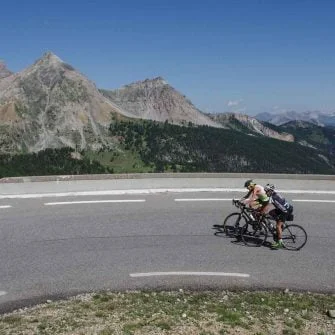
Last hairpin bend before reaching the summit of Col d’Izoard
Day 6 Barcelonnette – Beuil: Into the Maritime Alps
Located between the vast waters of the Serre Ponçon lake, the Col de la Bonette and the Col de Vars, the Ubaye valley is a road cyclist’s paradise.
The Uaye valley is also called the valley of the Mexicans due to the fact some of its inhabitants left for Mexico in the 19th century. They made money over there and then built picturesque villas in Jausiers and the major town, the charming Barcelonnette.
From there, you ride up on a lonely and beautiful route in the direction of the Col de la Cayolle. The road takes you deep into the Mercantour National Park. It’s your last col above the 2,000 m mark. You should take the time to enjoy its smooth slopes (total ascent of 30 km and 1,200 m of climbing, 4% average). There are wild mountains as far as the eye can see. This is wolf territory and both people and villages are scarce in this remote area.
From the pass, we descend into the Var valley, from where you start the climb to the Col de Valberg a short time later. It’s got a very regular but tiring slope of 7,5 % that ensures you cover the last 12 km and 900 m of climbing of the day and reach the small resort of Valberg.
After this last challenge, you easily reach your stage town Beuil, nested in the hills of the Maritime hills at an altitude of 1,400 m.
Route variant
Level 3 takes in, instead of Col de la Cayolle, the Col d’Allos (similar altitude gain, shorter but steeper than the Cayolle) and the Col des Champs (2,087 m). The latter is a less known mountain pass above 2,000 m with a short but intense climb from Colmars (11,5 km and 800 m).
Cols of the day
Col de la Cayolle, 2,326 m (level 2)
Col d’Allos, 2,250 m (level 3)
Col des Champs, 2,087 m (level 3)
Col de Valberg, 1,650 m
Distance and climbing
Level 2: 85 km and 2,200 m
Level 3: 110 km and 2,900 m
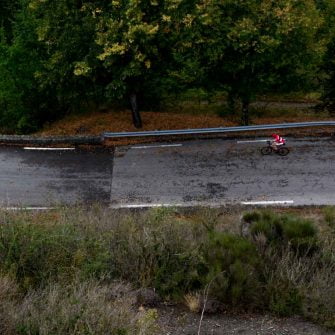
Autumn vibes on the narrow routes of the Southern Alps
Day 7 Beuil – Roquebillière: From the Maritime Alps to the turquoise waters of the Côte d’Azur
Today, it’s a long ultimate stage, with lots of smaller cols to cross before reaching the final descent to Nice and the Mediterranean Sea.
Early in the morning you take advantage of the freshness of the coniferous forests on the mountain flanks to descend over the Col de la Couillole into the narrow valley of the Tinée (7 km and only 300 m of ascent). There’s a wonderful descent on a winding, lonely route with refreshing waterfalls along the way.
Then it’s a steady climb up the Col Saint Martin for about 17 km with 1,000 m of altitude gain.
After the descent, the last real challenge is the 15 km climb to the Col de Turini at 1,600 metres. From the top of the pass, we head south along the Turini pass road. We then glide gently up and down the Col St Roch and the Col de Chateauneuf to Nice on the Côte d’Azur. It feels sublime to finally reach our destination, the Promenade des Anglais, after the exertions of the week. We round off this last day on the Mediterranean with an overnight stay and dinner in Nice.
Cols of the day
Col de la Couillole (1,678 m)
Col de Saint Martin (1,500 m)
Col de Turini (1,604 m) (level 3)
Col de la Porte (1,057 m) (level 2)
Col Saint Roch (990 m)
Col de l’Ablé (1,169 m)
Col de Chateauneuf (627 m)
Distance and climbing
Level 2: 130 km and 2,700 m
Level 3: 145 km and 3,200 m
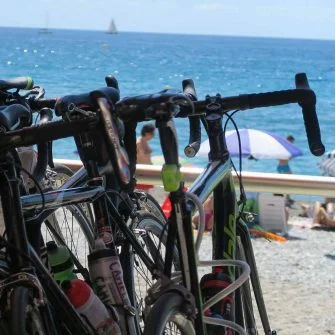
Reaching Nice on the Mediterranean Coast after eight days of cycling!
Want to join us on a Route des Grandes Alpes trip? You can find all the details here.
4. What are your favourite sections of the Route des Grandes Alpes and why?
There are so many amazing parts of this long route, it’s very difficult to pick a favourite. However, Col du Galibier on day 4 really stands out for the full experience of riding the relentless Telegraph, the lively town of Valloire, riding into the first ramp after Plan Lachat, and continuing after the tunnel of the Galibier on the last kilometre to the summit (snow remains aside the road in June and July, depending on conditions). Reaching the summit, with views on the Ecrins range and the glaciers of La Meije at 3,984 m, is incredible.
Other highlights
 Descent from Galibier to Col du Lautaret with La Meije and the Pic Gaspard as a backdrop (almost 4,000 m peaks)
Descent from Galibier to Col du Lautaret with La Meije and the Pic Gaspard as a backdrop (almost 4,000 m peaks)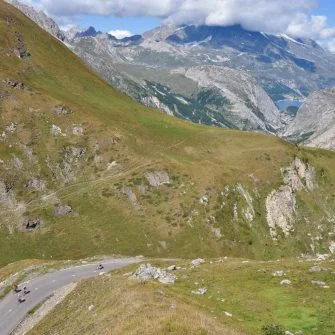 Alpine experience: green mountain slopes, windy roads and rough peaks
Alpine experience: green mountain slopes, windy roads and rough peaks5. How fit do you have to be to cycle the route?
In order to get the most out of this trip (and to avoid too much suffering!), we recommend you train on a regular basis, at least six months’ ahead of the trip.
We have had guests who had cycled less than 1,000 km for the preparation of this trip, but they often don’t enjoy it as much as they might do if they had greater base fitness.
Training rides
Before you set out, it’s sensible to have a good level of general fitness, ride regularly and have prepared with rides over 100 km in a day. It is important to spend a maximum of time in the saddle and search for hilly, and if possible mountainous, terrain (ideally, rides with > 1,500 m of climbing).
Training programmes
Training programmes can of course also include other sports for general fitness such as swimming, running (interval training and endurance) or mountain-biking. You could also add a test week-end with two longer rides several weeks before the trip – you shouldn’t under-estimate how different it is riding long, mountainous days back to back!
Ride at your own pace
Do not forget, in the end, it is crucial that you feel comfortable with the preparation you’ve put in place, and that you cycle the route at your own pace and experience.
6. What sort of logistics are involved?
Getting things organised before the trip
If we’re arranging the trip for you, we book your accommodation in our partner hotels in advance, give you all the necessary travel and equipment information, send you GPS tracks and road book for navigation (including must-dos and info about interesting stop-overs) and provide you with a support vehicle and with an extraordinarily nice tour leader. Throughout the tour preparation, you benefit from a personal and unique contact in our Vélorizons office. For your travel to the starting point and from the end point, we are happy to give advice on nearest airports or train stations, flight or train schedules and can provide transfers and supplementary nights in situ if needed.
On the day of departure
If you come on a supported tour with us, you will meet your tour leader in the morning of the departure at the rendez-vous in Thonon-les-Bains. After the luggage collection, rental bike delivery and check as well as a short briefing on the trip organisation (route and weather information regarding the first stage and its variants, potential dangers and the meeting point for lunch), you’re ready to head off.
Daily routine
On Vélorizons tours, every day your tour leader makes sure that you just need to cycle. They provide you with daily briefings (information on route variants, dangers, meeting points and so on), arrange the luggage transfer from one accommodation to the next including the check-ins, prepare the lunch break along the road and provide mechanical assistance as needed. In the hotels, they will facilitate if you need anything. All hotels are equipped with secured bike rooms and offer athlete friendly and delicious food, often based on regional products.
We also provide a support vehicle that’s equipped with standard spares (tubes, tires, rim break blocks, derailleur and brake cables), a comprehensive bike repair kit including a floor pump, and a first aid kit. Wind/rain/warm clothes are accessible for you during the stages, especially on top of the cols, as temperature variations can be high in the Alps. The support vehicle takes the same route most cyclists of the group choose to take.
Lunch breaks to recharge batteries: The tour leader chooses a central location along the route variant. For midday, we offer a balanced and athlete-friendly picnic lunch with fresh, regional products (energy-rich salad as well as savouries and sweets) and energy bars.
 View from the Col du Galibier on the high peaks of the Massif des Ecrins
View from the Col du Galibier on the high peaks of the Massif des Ecrins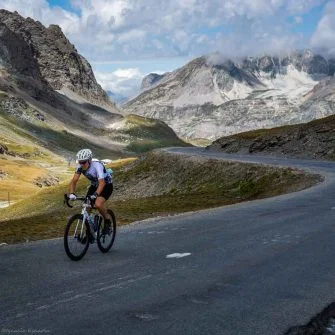 Grinding up the Col de l’Iseran
Grinding up the Col de l’Iseran7. Is there any particular kit you recommend people take for this trip?
Clothing
The Route des Grande Alpes is through the high Alps, so of course you might experience significant temperature variations (temperatures below 5°C and snow on top of the cols are rare but still possible in summer, in the valleys it can be between 30-35°C).
Do not forget, in addition to plenty of cycling jerseys: rain jacket, windbreaker, arm and leg warmers, warm gloves, over-shoes, neckerchief/neck warmer, helmet, a cycling cap and sun cream.
Gearing
You should also check the gear ratios of your road bike before leaving home, and get advice from a professional. We recommend a 50-34 compact crankset combined with a 11-32 cassette. This allows you to ride rather easily all difficult sections of the Route des Grandes Alpes with maximum percentages around 10%.
Make sure your bike is in good repair
Also make sure that your bike is in perfect condition for the 700 km ride, especially tires, brakes and their blocks/pads.
If you come on one of our trips, we have high quality carbon road bikes available for rent, including delivery to the tour start and return. You’ll also be lucky enough to be riding with a support vehicle, so take advantage of it and bring clothes for all season riding.
8. What tips would you give to someone wanting to tackle the Route des Grandes Alpes?
When to go
The best periods to tackle the Route des Grandes Alpes are the second half of June (to ensure all the cols are open – the highest ones are only accessible from mid June) and early September. These times also ensure there’s less traffic along the route than in high summer and also lower temperatures.
Temperatures
It can be really hot in some sections in summer, particularly on the Colombière, Savoy Prealps and the Southern Alps around Turini. During mid summer, the heat becomes often stormy in the Northern Alps before passing the Lautaret, the climate in the Southern Alps is much dryer and in the Maritime Alps even Mediterranean.
For such a trip across more than a dozen high cols it is important to stay warm after the climbs for the descents. Our support vehicle provides the opportunity to grab wind/rain/warm clothes on the way or on the top of the cols.
Get local expertise to avoid the traffic
Bear in mind that the classic Route des Grandes Alpes was principally designed for cars, that are less concerned about main roads with traffic. Years of experience means that we’ve tailored our trip route so that it avoids such bottlenecks where we can. If you’re just following the classic route, take special care especially in these busy valley sections.
Plan
If you’re going without a guide, really take the time to study the route in advance. Think about danger points, like traffic and tunnels, and study the weather forecast the night before to check for any adverse conditions. On our trips our tour leaders hold daily briefings on danger points and weather conditions for the next stage during dinner in the evening.
Riding tips
It’s important to keep to your personal pace and not overestimate your performance by following others.
Also remember to eat well and use the time off the bike to recover for the next day!
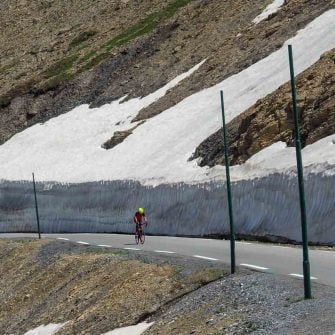 Last hundred meters of the Galibier, flanked by snow in June
Last hundred meters of the Galibier, flanked by snow in June Steep section after Plan Lachat, the Cerces mountains in the background
Steep section after Plan Lachat, the Cerces mountains in the backgroundPart 2: Alps cycling tours
9. What makes your Route des Grandes Alpes (Geneva to Nice) cycle tour special?
The ultimate challenge
Our French Alps Traversee is the ultimate cycling challenge for road cyclists. It combines the best of the Western European Alps (natural and cultural heritage of the more famous Northern Alps and the wilder and more remote Southern Alps) from North to South on a unique itinerary and allows you to tackle the legendary climbs of the Tour de France.
Supported self-guided trips
What makes our trips different is that they are a cross between guided and self-guided trips. In our opinion, they give the best of both worlds. We deal with all the admin of hotel bookings and luggage transfers, plus provide a support vehicle and the knowledge there’s someone nearby who can help you if body or bike break down – without the downsides of being on a formal, guided tour (for example, the high price tag and the need to ride in a group/at someone else’s pace).
Our trips allow you to either ride alone or with other group members and meet the others at lunch or at the accommodation. Our tour organisation is the backdrop for your adventure, but you’re free to go at your own pace and have more flexibility than on many tours.
Local expertise
While our itineraries generally follow the classic Route des Grandes Alpes, we use our knowledge of the mountains and local expertise to
This way you get more out of your trip – and can tailor it to your fitness and cols you want to tackle.
Hassle-free
The trip is fully-catered, offering 100% service while keeping things simple and flexible: you just have to cycle. Vélorizons/France Bike Trips offers departures almost every weekend from mid-June to mid-September.
You can check our next departures (currently confirmed trips) any time on our website: https://www.france-bike-trips.com/road-bike/next-tour-departures.html
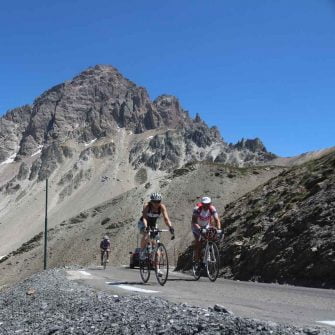 Reaching Col du Galibier with the Grand Galibier in the back
Reaching Col du Galibier with the Grand Galibier in the back Relaxing break at the summit of the Galibier
Relaxing break at the summit of the Galibier10. How does the Route des Grandes Alpes cycling route compare with some of the other great long-distance cycling routes in Europe?
Here in France, we are lucky to have some of the best bike routes in Europe.
For us, there is nothing more appealing than crossing entire mountain ranges on a road bike. With the courage and ambition to tackle each new pass, with the joy of discovering another charming valley on the other side, and with a fixed destination in mind, preferably of course the coast!
Besides the always popular Route des Grandes Alpes trip, there are two other trips our clients always love and which are comparable with the Routes des Grandes Alps: crossing the Pyrenees and the Central Massif.
Cycling across the Pyrenees
Our road bike trip across the Pyrenees starts in the lovely port of Collioure on the Mediterranean coast, in the Northern French part of Catalonia.
In eight days, we cross the French side of the Pyrenees from East to West with some loops across the Spanish border.
From valley to valley, we pass successively through the Mediterranean vegetation in the foothills of the Serra de l’Albera, the dense forests of the Ariège, the craggy peaks of the High Pyrenees and the green mountains of the Basque Country. At the end of our adventure, the Atlantic Ocean shimmers in the evening sun on our descent to Saint Jean de Luz.
The central part of the Pyrenees is particularly famous with road cyclists and this route takes in the Col de Peyresourde, Col d’Aspin, Col du Tourmalet, Col d’Aubisque and Col de Marie Blanque. The Eastern and Western parts of the Pyrenees offer splendid riding on narrow mountain roads with almost no traffic.
Combined with the Mediterranean and mild Atlantic climate, crossing the Pyrenees is a road biking experience in a class of its own.
On our trips, two levels of difficulty are available. To give you an idea, the distance and climbing at level 2 is 770 km and 17,100 m.
There’s more information on this trip here.
Cycling across the Massif Central
Our route takes you through the entire « Vieux Massif », one of the wildest and most isolated regions in France, from Clermont-Ferrand to the Mediterranean.
The diverse landscapes of this million-year-old mountain range of extinct volcanic giants, impressive gorges and high plateaus await you with challenging mountain roads, great vistas and lots of climbing.
Our tour takes in some spectacular cols (including the Pas de Peyrol, the highest road pass in the Massif Central), as well as some rich and diverse scenery in the Auvergne and Occitan regions: the volcanic Puy mountain range, the Monts Dore, the Cantal, the Aubrac, the Causse Sauveterre, the Tarn and Jonte gorges, the Mont Aigoual, the Cévennes, the Hérault gorge, before a dramatic seaside finale in the pretty fishing port of Sète, a small port town also known as the “Venice of Languedoc” for its charm.
We offer three levels for this trip. To give you an idea, the total distance and climbing at level 2 for this trip is 820 km and 13,400 m.
There’s more information on this trip here.
Which is the hardest cycling route?
Our Pyrenees trip along the official Route des Cols compares to the Route des Grandes Alps with regard to distance and climbing. However, it’s worth bearing in mind that some of the smaller passes of the Pyrenees have less regular gradients and slopes can easily exceed the 10% mark. Some guests might therefore consider that the Pyrenees are harder to ride than the Alps. The most difficult section is 3 km of 13% on the way up to Col Bagargui. This is really tough, especially on day 7 of such a trip.
Our route through the Central Massif trip is less mountainous and perhaps easier.
Both the Pyrenees and Central Massif are wilder, less touristic and less populated than the Alps. They’re fantastic.
11. What other cycling tours of the Alps do you offer?
We’ve got some really great trips on offer for both cycling in the French Alps but also many other parts of France.
I’ve listed some of my favourite trips below – do feel free to contact Dominik on +33 458 140 435 or info@france-bike-trips.com if you’d like to discuss which is the best trip for you. Our whole team is based in France, but we speak English!
The Grand Tour of Provence
This offers year-round riding through the superb mountains of Provence, under the watchful eye of the Mont Ventoux. Our 8-day round trip starts in Cavaillon, takes in the mountains of Provence, the Southern Pre-Alps and the Mont Ventoux.
French Riviera Mountain Pass Tour
A 7-day round-trip along the Côte d’Azur and through its hinterland, taking in beautiful coastal roads, wonderful cols and the Verdon Gorges. Start and end point is Nice. Year-round riding possibilities; many professional cyclists made the Côte d’Azur their base-camp due to the possibility of year-round riding.
Italian Alps Traversee (Part 1 of the Great Alpine Crossing)
An 8-day crossing of the Italian Alps from Trieste on the Adriatic to north of Bergamo in Lombardy. It’s 675 kilometres and 9,000 metres of climbing that takes in the Triglav National Park in Slovenia, the Julian and Carnic Alps, the fantastic Dolomites and the Ortles range. It’s the first part of the Great Alpine Crossing and is followed by the Swiss Alps Traversee (Part 2 of the Great Alpine Crossing) and the Route des Grandes Alpes (Part 3 of the Great Alpine Crossing).
Swiss Alps Traversee (Part 2 of the Great Alpine Crossing)
In 6 days you can cross the stunning passes of the Swiss Alps between Lake Como and Lake Geneva, taking in 12 major mountain cols including iconic climbs such as the Splügen, Gotthard and Furka passes. It’s the second part of the Great Alpine Crossing and is followed by the Route des Grandes Alpes (Part 3 of the Great Alpine Crossing).
Tour of the Dolomites
The Dolomites have to be seen (or even better, ridden) to be believed. A UNESCO protected landscape that will challenge and wow you. This 7-day trip covers both the Dolomnites and Italian Alps, including the Stelvio, Gabia, Gia, Fedaia and Tre Cime.
Giants of the Alps round trip
Last but not least, I love this more local ride in the French Alps, starting in Albertville: a 6-day journey across the major cols of the Northern French Alps. Like the Route des Grandes Alpes, it takes in Roselend, Iseran and Galibier, but it also adds Alpe d’Huez, Col de Sarenne, Col de la Croix de Fer, La Toussuire, the Lacets de Montvernier and finally, the Col de la Madeleine. If you want to ride the cream of the crop of Tour de France passes, this one is for you.
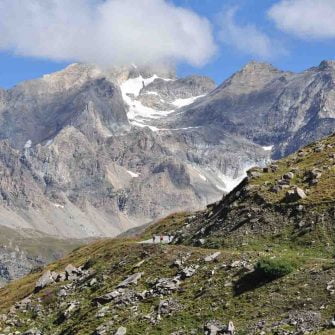 Winding road up the Col d’Iseran
Winding road up the Col d’Iseran Riding through the moon landscapes of the famous Casse Déserte, just below Col d’Izoard
Riding through the moon landscapes of the famous Casse Déserte, just below Col d’Izoard12. What’s the best way for people to find out more about your cycling holidays?
The easiest way to find out more is to take a look at our website on www.france-bike-trips.com. You can check our confirmed trips via our next departures section on our website at any time: https://www.france-bike-trips.com/road-bike/next-tour-departures.html
France Bike Trips is the UK branch of our cycling tour company Vélorizons.
For more information contact our France Bike Trips head Dominik, via our website or directly via email at info@france-bike-trips.com.
We are also happy to answer your questions on the phone: +33 458 140 435 (landline in France).
Our team speak English and are very approachable. We love to chat about road cycling trips!
A big thank you to Vincent for taking the time to share his expertise on the Route des Grandes Alpes.
And finally, a thought from us: we think Velorizons’ semi-supported bike trip offers a great middle ground for those cyclists that don’t want or need a guide with them, but who would still like someone to do the boring bits involved with organising a bike trip – and would like a support car. What a great idea!
It’s also notable that (at the time of writing) there are many confirmed dates during the summer, almost every week-end; not many operators offer this kind of flexibility.
The Routes des Grandes Alpes features in our list of the best European cycling routes and World’s best cycling routes. Read those articles to find out why!
For further information on cycling in Geneva, this article may be useful. Likewise, this article on cycling around Lake Geneva.
Got a question for Vincent?
Fill out this form and we will send it to Vincent. We aim to get you an answer within 24 hours wherever possible!
The contents of this website are provided for general information purposes only. It is not intended to amount to advice and you should not rely on it. You should carry out your own due diligence and risk assessments and take professional advice. Views expressed by interviewees or other users of this website do not necessarily represent our views. We make no representations, warranties or guarantees, whether express or implied, that the content on our website is accurate, complete or up to date. If you use any information or content on this website, download from, or otherwise obtain content or services through our website, it is entirely at your own discretion and risk. Epic Road Rides Ltd disclaims all liability and responsibility arising from any reliance placed on the information and content on this website. Find out more here.
Looking for help organising your Alps cycling holiday?
Vélorizons (and its UK branch, France Bike Trips) have been offering self-supported, semi-supported and fully supported cycling holidays in France since 1999.
As a local France-based business, they live and breath France, they know all the best hotels and service providers and can provide trips that other non-French companies simply can’t. They’re usually much more cost-effective too…
If you want someone to take the hassle out of your next cycling holiday in France, these guys can help. And they all speak fantastic English too.
Just make sure you let them know we sent you!
Get in touch with Vincent, Dominik and the team:
info@france-bike-trips.com

